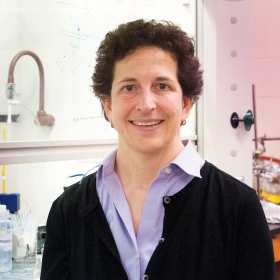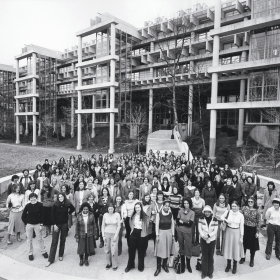Katherine Haines Freeman ’84
Katherine Haines Freeman ’84, Evan Pugh University Professor of Geosciences at Pennsylvania State University, studies tiny amounts of what are called biomarkers from ancient plants, algae, and bacteria, to learn more about past environments and climates.

Imagine you are out for a stroll through the tall trees lining Lake Waban. You stop to gaze at the sun shimmering on the surface of the water. Maybe you pick up a fallen leaf. You run your thumb over the thin wax that covers the leaf, which protects it from drying out or being gobbled by insects. You might drop the leaf and move on, but for Katherine Haines Freeman ’84, that wax is as good as gold. Or, at least, it will be when it’s a few million years old.
Kate, Evan Pugh University Professor of Geosciences at Pennsylvania State University, studies tiny amounts of what are called biomarkers from ancient plants, algae, and bacteria, to learn more about past environments and climates. She’s used these biomarkers, including wax from leaves, to reconstruct atmospheric CO2, patterns in rainwater, and changes in plant ecology throughout history. “You can imagine a giant dinosaur bone,” Kate explains. “[Biomarkers] are the opposite end—tiny molecules that are fossils, a chemical debris from past organisms. They clue us in to what those organisms were and what their environments were like.” She loves the irony of it—using things that are so tiny you can’t even see them to answer big questions about our planet’s history.
Her research has garnered more than a little attention, as she was elected to membership in the National Academy of Sciences in 2013, one of the highest honors awarded to American scientists. She’s come a long way since her father, now a retired chemistry professor, gave her a chemistry kit that she and her three brothers used to set their old toys on fire, just to see what would happen when they burned. (Kate’s mother, Linda Lee Reiss-Freeman ’57, balanced their scientific education by reading them 19th-century British literature.)
Destroy something to see what it’s made of—it’s a tactic Kate still employs today. For example, a 2-million-year-old rock excavated from the Olduvai Gorge in Tanzania recently entered her lab at Penn State. This rock bore witness to the homo habilis, probably the first early human species. Researchers disagree about what they ate, based on the properties of and marks on their teeth, and the size of their jaws. Kate and her students wanted to figure it out. The road to such discoveries began with grinding the rock into a fine dust, fishing out the desired compounds using chemical processes, and combusting mere nanograms of the sample. The information came from interpreting the molecules’ remaining number of isotopes (or forms of a given element). The data, along with that from many others samples, revealed that a variety of ferns, sedges, and little animals populated the area. “What we found is that there actually was a diverse set of things they could have been eating,” Kate says. “So the answer is that there were lots of dietary choices—it was more like a banquet.”
But that research is about more than what our ancestors ate for dinner, as is the case for most of Kate’s work. She is a time-traveler of sorts, moving between ancient and modern contexts to learn more about the Earth’s patterns. Her work in Africa, for example, has made her realize how susceptible that part of the world in particular is to changes in vegetation and water. “Humans can perturb those conditions very quickly without trying too hard,” she explains. “The more I look at climates in the past, the more context I get for understanding what might be happening to us now.”


